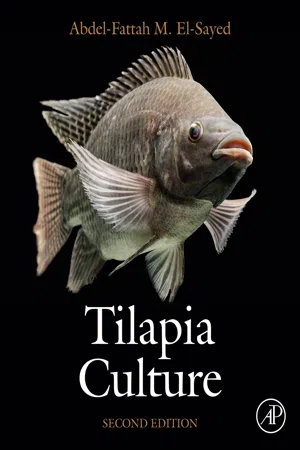
- 358 pages
- English
- ePUB (mobile friendly)
- Available on iOS & Android
About this book
Tilapia Culture, Second Edition, covers the vital issues of farmed tilapia in the world, including their biology, environmental requirements, semi-intensive culture, intensive culture systems, nutrition and feeding, reproduction, seed production and larval rearing, stress and disease, harvesting, economics, trade, marketing, the role of tilapia culture in rural development and poverty eradication, and technological innovations in, and the environmental impacts of, tilapia culture. In addition, the book highlights and presents the experiences of leading countries in tilapia culture, thus making it ideal for tilapia farmers and researchers who seek the most relevant research and information.The new second edition not only brings the most updated information within each chapter, but also delivers new content on tilapia transfers, introductions and their impacts, the use of probiotics and other additives in tilapia culture, tilapia trade, including marketing, and sustainability approaches and practices, such as management practices, ecosystem approaches to tilapia culture, and value chain analyses of tilapia farming.- Presents the biology of tilapia, including taxonomy, body shapes, geographical distribution, introductions and transfers, gut morphology, and feeding habits- Covers semi-intensive tilapia culture in earthen ponds, tanks, raceways, cages, recirculating systems, and aquaponics- Provides the latest information on brood stock management, production of monosex tilapia, seed production, and larval rearing under different culture systems- Highlights the most common infectious and non-infectious diseases affecting farmed tilapia, with a full description of disease symptoms and treatment measures- Provides an in-depth exploration of tilapia economics, trade and marketing
Frequently asked questions
- Essential is ideal for learners and professionals who enjoy exploring a wide range of subjects. Access the Essential Library with 800,000+ trusted titles and best-sellers across business, personal growth, and the humanities. Includes unlimited reading time and Standard Read Aloud voice.
- Complete: Perfect for advanced learners and researchers needing full, unrestricted access. Unlock 1.4M+ books across hundreds of subjects, including academic and specialized titles. The Complete Plan also includes advanced features like Premium Read Aloud and Research Assistant.
Please note we cannot support devices running on iOS 13 and Android 7 or earlier. Learn more about using the app.
Information
Current state and future potential
Abstract
Keywords
1.1. Historical review∗
Table of contents
- Cover image
- Title page
- Table of Contents
- Copyright
- Preface to the Second Edition
- Chapter 1. Current state and future potential
- Chapter 2. Taxonomy and basic biology
- Chapter 3. Tilapia distribution, transfers and introductions
- Chapter 4. Environmental requirements
- Chapter 5. Semi-intensive culture
- Chapter 6. Intensive culture
- Chapter 7. Nutrition and feeding
- Chapter 8. Reproduction and seed production
- Chapter 9. Stress and diseases
- Chapter 10. Harvesting, processing, economics and value chain
- Chapter 11. Tilapia trade and marketing
- Chapter 12. The role of tilapia culture in rural development
- Chapter 13. Technological innovations
- Chapter 14. Environmental impacts
- Index